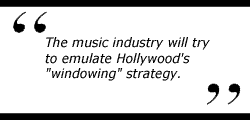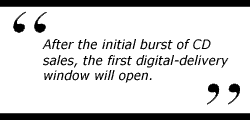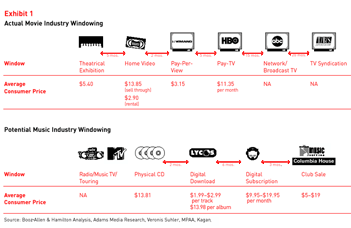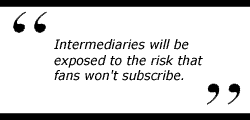Online Music Gets a Hollywood Strategy
When music labels offer online subscription services, they risk cannibalizing current CD sales. To expand the entire music market, the labels should adopt the movie industry's "windowing" approach and create distinct value propositions for retail and digital channels.
Consumers jolted the music industry in the late 1990s when they embraced new technologies that let them download and swap music online. Now, the five major music companies are racing to build their own online music services.
Their strategy is centered around two joint ventures between leading labels and online players. Bertelsmann, AOL Time Warner, and EMI Group have joined with RealNetworks to form MusicNet, whereas Vivendi Universal and Sony are backing Pressplay. These ventures, acting in a new intermediary distribution role, will license music subscription services to third parties like AOL and Yahoo. The intermediaries, MusicNet and Pressplay, are planning to start delivering music by late this summer.
As intermediaries roll out label-sanctioned services, we believe the music industry will try to emulate the strategy called "windowing." This approach has been very successful for the film industry and has helped it adapt to waves of technological change over the past 50 years. Windowing — or releasing films through different channels at strategically timed intervals — helped expand U.S. film revenues from $2 billion in 1974 to $33 billion in 1999. Today, about 75 percent of domestic revenues are derived from home video and pay-TV platforms.

The combination of digital technology and sequenced release schedules will position the music industry for similar long-term growth. It will transform the industry in several ways:
- Consumers will gain new ways to buy and enjoy music, differentiated by platform, product features (e.g., listen-only or download), and price.
- New channels will give rise to new business models, and intermediaries will become the industry's primary point of contact with online consumers.
- The labels' role will change as they focus less on physical distribution and more on developing and marketing artists.
Windows Expand Revenues
How will the intermediaries package, price, and deliver music? The film industry's windowing strategy suggests the answer. Films are released in distinct channels organized in a set sequence. A new window opens as revenues in the preceding window decline. In this way, the film industry has been able to keep revenues for a single production growing over time by creating different value propositions for distinct consumer segments: Those who like to watch first-run movies in theaters, rent or buy videos, order pay-per-view showings, and hold out for the for cable TV or network broadcasts.
Applied to the music industry, windowing could protect existing revenue streams (i.e., retail sales of CDs) and still offer consumers other ways to purchase music. Total revenues should expand as the industry taps into consumer segments that prefer to buy digital music via streaming or file delivery.
For decades, consumers had limited ways to enjoy music. They could buy full-length albums and cassettes or listen to free radio broadcasts. The introduction of the compact disc caused a surge in back catalog sales throughout the '80s and '90s, but then music sales flattened after consumers had finished replacing their vinyl albums and the CD platform had become a standard. In the late '90s, however, the MP3 format and Napster's peer-to-peer file sharing system rekindled the enthusiasm of music fans. Now labels — through their intermediary ventures MusicNet and Pressplay — hope to further fuel music lovers' passions through label-supported subscription services that assure labels their piece of the action.

Here's how labels could use windowing to meet different customer segment needs: Distribution starts at the same point it does today, with a CD release and radio/TV promotion. Avid fans eager to own a hot release pay a premium retail price, from $13 to $18 for the CD. After the initial burst of sales, the first online window opens, allowing digital music fans to download certain singles or the entire album. The next window includes subscription services, whereby for a monthly fee, consumers can access a selection of music, perhaps defined by genre or artist. The last step in the sales chain is the record clubs, which cater to price-conscious consumers. (See Exhibit 1.)
Exhibit 1
New Risks and Rewards
Because music today is sold mostly through physical formats such as CDs, the music industry needs a new business model to accommodate windowing that incorporates digital distribution. Major labels and retailers currently split retail revenues on a 75/25 basis, with the labels claiming the larger slice because they bear the most risks: Handling the artists, financing and producing the CD or cassette, manufacturing and distributing the end product, and providing retail marketing support.
Going forward, a new model will reflect the new digital revenue streams and the role of digital intermediaries. In this music world, the intermediaries will take on a much larger role in packaging, promoting, and distributing music licensed from labels. The intermediaries will also be exposed to the risk that consumers won't download the songs or subscribe to their services. With this role, intermediaries could claim at least 50 percent of the online revenues they generate, far more than retailers' current 25 percent share of sales.

Pay-TV services like HBO provide a model for the music industry. The services license movies from studios, then handle promotion and scheduling. A pay-TV service may help finance the production of a slate of movies, gaining the rights via a transaction called an output deal. The pay-TV service bears the risk that the movies, once released, may lack customer appeal, and thus could harm the service's ability to attract and maintain subscribers. Due to its role and the risks involved, pay-TV services get a 60 to 70 percent cut of the average $11.35 per month that cable subscribers pay for such a premium service. By the same logic, intermediaries in digital music could claim a major portion of subscription revenues.
Windows on the Future
Even as windowing and digital delivery transform the business model, labels will remain the hub of the music industry. They alone have the artist and retailer relationships, marketing and promotional prowess, and music libraries. Still, as labels reduce their focus on physical distribution to concentrate on artist relations and the growth and security of digital channels, their role will change. Watch for major impact in these areas:
- Talent development. The labels' talent hunters (the artist and repertoire, or A&R, staff) will increasingly use the Internet to find promising artists, and this will reduce the need to gamble on unknown acts. A&R will work with fewer, stronger acts, and will focus on nurturing and retaining those artists.
- Channel and selection management. New packaging and distribution value propositions must be carefully managed to maximize revenues and avoid conflicts among channels or copyright holders. For example, the selection of available songs will be adjusted constantly, as some are removed to prevent overexposure and others are added to refresh the product mix.
- Customer understanding. Better CRM skills will be needed to leverage customer information flowing in from online channels. Today, labels know relatively little about what consumers are buying, or why.
Digital distribution is a major change for the music industry, but the entertainment business overall has shown it can successfully adapt to disruptive technologies. The labels have seized the digital opportunity and are rolling out their strategies. Soon, the new intermediaries will reshape the retail music landscape, giving fans more options for buying and listening to digital music, while the creators and distributors of music will have new ways to make more money. Will fans be able to gain one-stop access to every song ever released? Probably not. Will they welcome services feeding their hunger for new and catalog selections? That's the aspiration. We'll find out soon, when the music industry opens the windows into its future.
The authors also wish to thank Matthew Shatz and Jeffrey Ocampo-Tan for their extensive contributions. Both are Associates in Booz-Allen & Hamilton's New York office and have worked on engagements involving the music and film business.
| Authors
G. Krishan Bhatia, bhatia_krishan@bah.com G. Krishan Bhatia is a senior associate with Booz Allen Hamilton in New York. He focuses on helping media and entertainment companies develop growth strategies and create value by leveraging digital technologies. Mr. Bhatia’s clients include many of the leading recorded music, filmed entertainment, cable television, and online companies, as well as related retail businesses. Richard C. Gay, gay_richard@bah.com Richard C. Gay is a vice president with Booz-Allen & Hamilton's Media and Entertainment Practice in New York. He specializes in the development of corporate and business strategies for media and entertainment companies. Mr. Gay holds an MBA from Stanford University and a BS in economics from the University of Pennsylvania's Wharton School of Business. He can be reached at 212-551-3899. W. Ross Honey, honey_ross@bah.com W. Ross Honey is a principal with Booz-Allen & Hamilton's Media and Entertainment Practice in New York. He has extensive experience in developing digital growth strategies and new business models for companies in the music and filmed entertainment industries. Mr. Honey holds an MBA from the Fuqua School of Business and a BA from Duke University. He can be reached at 212-551-6020. |




